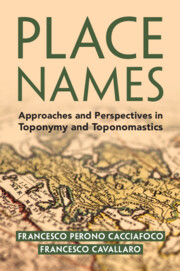Book contents
- Place Names
- Place Names
- Copyright page
- Contents
- Figures
- Tables
- Preface
- Acknowledgements
- 1 Introduction
- 2 Language Change
- 3 Historical Toponomastics
- 4 Toponymy and the Historical-Linguistic Reconstruction of Proto-Languages
- 5 Diachronic Toponymy
- 6 Landscape and Toponymy
- 7 Historical Toponomastics and Historical Geography
- 8 Synchronic Toponymy
- 9 Place Names and Society
- 10 Toponymy and Cartography
- Glossary
- References
- Index
3 - Historical Toponomastics
Published online by Cambridge University Press: 02 March 2023
- Place Names
- Place Names
- Copyright page
- Contents
- Figures
- Tables
- Preface
- Acknowledgements
- 1 Introduction
- 2 Language Change
- 3 Historical Toponomastics
- 4 Toponymy and the Historical-Linguistic Reconstruction of Proto-Languages
- 5 Diachronic Toponymy
- 6 Landscape and Toponymy
- 7 Historical Toponomastics and Historical Geography
- 8 Synchronic Toponymy
- 9 Place Names and Society
- 10 Toponymy and Cartography
- Glossary
- References
- Index
Summary
Historical toponomastics is the discipline that deals with the reconstruction of the roots of toponyms in the context of well-known languages/language families (e.g., Indo-European) and in the presence of available historical records. The analysis of the etymology and morphology of a place name occurs not just at the linguistic level, but also incorporates the assessment of the territory’s geology and hydro-geo-morphology. This chapter presents a step-by-step guide in historical toponomastics that involves both linguistic and extra-linguistic analyses. The authors apply this to two toponyms from the Indo-European language family, Sessame and Squaneto, both located in Piedmont, northwest Italy. This chapter also discusses the notion of ‘folk etymology’ and ‘toponymic paretymology’, often observed in the stories told by local speakers trying to explain the origins and meanings of their toponyms. These ‘explanations’ may not always be accurate. These, indeed, originate from the linguistic misinterpretations of place names, when the original morphology and/or meaning of toponyms are lost over time. This chapter explores two types of toponymic paretymologies – ‘bona fide paretymology’ and ‘scholarly paretymology’, with examples from both Indo-European and non-Indo-European contexts. The chapter also presents an in-depth discussion of contact etymology.
Keywords
- Type
- Chapter
- Information
- Place NamesApproaches and Perspectives in Toponymy and Toponomastics, pp. 46 - 79Publisher: Cambridge University PressPrint publication year: 2023



